« September 2014 | Main | November 2014 »
October 30, 2014
Prince of the Night

Nosferatu a Venezia
Augusto Caminito - 1988
One 7 Movies Region 0 DVD
I'm not entirely sure what to make of Prince of the Night, starting with why One 7 Movies would bother creating a new English language title. Nosferatu in Venice sums up all you need to know. That the film stars Klaus Kinski is enough to inform most interested viewers that Kinski is reprising the title role in Werner Herzog's film from 1979. The film is not really a sequel to Herzog's film, nor does it really have much to do with F.W. Murnau's silent classic, other than the name of the vampire. More confounding is that it's a film that might have actually been better than what we have here had the production not been disrupted by the whims of the star.
Original director Mario Caiano doesn't have the most distinguished filmography, but it does include Nightmare Castle starring Barbara Steele. Reportedly Caiano was fired at the request of Kinski. According to IMDb, Maurizio Lucidi, who directed the very good Designated Victim, had a hand, as did Luigi Cozzi of Starcrash infamy, as well as Kinski. Directorial credit went to producer Augusto Caminito. While there is no discernible sense of visual style, the chaos of the production may at least partially explain why what is seen is serviceable most of the time, when the film could have benefitted from a better composed and lit shots.

Most of the action takes place at a mansion in Venice, where the Van Helsing proxy, Professor Catalano, shows up at the request of a princess. The legend is that Nosferatu was last seen in Venice in the 18th Century. Rather than assuming that the vampire has finally died or at least has found new hunting grounds with a new identity, Catalano and company have a seance which brings Nosferatu back to life. As it's carnival time, Nosferatu's centuries old clothing fits in quite well with the rest of the revelers. In this movie, Nosferatu has no fear of crucifixes, crushing one in his hand, and making the one held by Catalano red hot, burning the professor's hand. He also sees his reflection. Shotgun blasts through the stomach don't stop this vampire. What is suppose to kill Nosferatu is the love received from a virgin. And sure enough, there's a young woman ready to give her all, with little concern that the object of her affection is a nocturnal blood sucker, or that there is a considerable age difference.
As it turned out, Christopher Plummer, who plays Catalano, also played Abraham Van Helsing in Dracula 2000. The DVD comes with both English and Italian language tracks. I chose English in part to hear Plummer and Donald Pleasance in their own voices. Pleasance appears as a priest, a resident of the mansion. Having Plummer and Pleasance in the cast helps provide some instant gravitas to the film. Evidently, Pleasance must have enjoyed whatever work he did with Cozzi to work with him the following year on The Paganini Horror. Whatever pathos Kinski brought to the role of Nosferatu under Herzog's direction is absent here. Most of the time, Kinski just glares at the camera. His vampire visage, with the rodential teeth, is seen very briefly. Kinski took the role in order to finance his pet project, Paganini, what turned out to be his final film, and not to be confused with Cozzi's film. Of course, frolicking onscreen with a naked young lady might have had some incentive for the volatile actor.
With whatever was spent on providing something resembling star power, there wasn't much for special effects. A scene with with Nosferatu flying over Venice with his virgin in his arm is very obviously a superimposed shot, the kind that barely passed muster in cheapjack science fiction movies more than fifty years ago. Venice, usually seen at night, and a few fog machines, do most of the heavy lifting here, providing the kind of atmosphere that was probably used best in Don't Look Now. In a French interview, Luigi Cozzi describes the film as a catastrophe. And upon closer examination, the film is cobbled together with various elements that don't quite fit. It's a film maudit, alright, but one that is watchable for its own idiosyncratic pleasures.

Posted by Peter Nellhaus at 06:43 AM
October 28, 2014
Body Count

Camping del Terrore
Ruggero Deodato - 1986
Quadrifoglio All Region DVD
I just had to look. An Italian slasher film that takes place in Colorado. Starring Mimsy Farmer. What could go wrong?
I'm not sure how much was actually filmed in Colorado. IMDb says that Body Count was filmed in Abruzzo, Italy. If that was the case, it sure looks more convincingly like Colorado than what I've seen in several Hollywood films. A couple of details that Deodato and company got wrong were that at one point there's a sign for Interstate 80, which is north of Colorado, in Wyoming. I know because I drove from Oakland to Denver on that route. The main highway that winds through the Colorado Rockies is I-70. Also, at the camp where most of the film takes place, there's a big sign for Schlitz Beer. This could only take place in a parallel universe. Sure you can get your choice at your favorite place to imbibe, but if you're only going to have one sign at your drinking establishment, it better be for Coors. It's not quite like in Amsterdam where there are big neon signs for Heineken on virtually every corner, but you get the idea.

Anyways, the film takes place somewhere in Colorado. A high school girl goes off to a cabin with some guy, they have sex, and the girl, wandering in the woods, gets killed by someone with a very big knife for no apparent reason. Anybody looking for logic might as well give up at this point. There's no reason why a bunch of kids would want to go camping at a lodge that the owner declares is closed, and you have to wonder why no one check on the place before going there in the first place. The camp is run by a married couple played by David Hess and Mimsy Farmer. Hess made a reputation for himself as one of the home invaders in Last House on the Left so already he's under suspicion. Mimsy Farmer provided nightmares for Michael Brandon in Four Flies on Grey Velvet so you know that she's probably not to be entirely trusted. In addition to this pair being a match made in Hell, Mimsy is having an affair with Sheriff Charles Napier, the square jawed hero of several Russ Meyer movies. Seeing Farmer and Napier together was almost as horrifying for me as it is for Farmer's movie son.
So is the murderous "Old Indian" real, or part of somebody's imagination? Whoever or whatever he is, he goes around murdering the visiting kids - usually with long, sharp metal implements. Now you would think that the guy who gave the world Cannibal Holocaust would make a movie where sudden death would be accompanied by lots of tasteless gore and violence. Disappointingly, no. When the Italian DVD box features a rating saying the movie is acceptable for those older than 14, you know that whatever happens, it's not going to be very scary. And sure, there is some gratuitous nudity as well, but just not very much of it. This definitely the kind of movie that would benefit from at least one scene with someone's head on a stick.

Posted by Peter Nellhaus at 07:58 AM
October 27, 2014
Starz Denver Film Festival 2014 - The Schedule

Just as those presenting films are being forced to adapt to new technologies, Quentin Tarantino to the contrary, so do those of us who write about film. Last year, the Denver Film Society raised enough money to be able to stay on top of these changes, get digital projectors for all three of their screens at the Sie Theater. This year, critics and journalists covering the festival will no longer be fighting for access to a limited number of DVD screeners, but will be getting video links, increasingly popular especially with the smaller distributors. With that in mind, I have purchased a Roku to hook up with my own television in the hopes that through Vimeo, I can avoid seeing the new Dardenne brothers' work on a thirteen inch laptop. There may be some theatrical screenings for critics, but with my work schedule, certain realities in my life have to get in the way.
As in the past couple of years, screenings will primarily be at the Sie Theater's more intimate auditoriums, as well as several screens at the larger Regal / UA Denver Pavilions multiplex in downtown Denver. Marion Cotillard on the big screen with stadium seating? Mais, oui!
This year, the festival takes place after the more high profile A.F.I. festival in Los Angeles. Even so, the schedule doesn't have some of the more high profile films that have been on the festival circuit. For myself, the most conspicuous absentee would be Godard's Farewell to Language, disappointing as the Denver Pavilions theater is set up for 3D movies.
This year's Stan Brakhage Award goes to Larry Jordan. Like Brakhage, Jordan also went to Denver's South High School, something I wrote about a few years ago. This is one of the events at the film festival I hope to attend.
I'm not familiar with Roberto Ando, but his newest film, Viva La Liberta will be screened. Ando gets the Maria & Tomasso Maglione Italian Filmmaker Award, a monetary prize named after the parents of the wife of Starz founder John Sie. Italy's Oscar contender, Human Capital is also on the schedule.
There's also a focus on Brazilian cinema, concentrating on newer filmmakers. If I hadn't gone to the Far East Film Festival in Udine, Italy, I would be more frustrated by the virtual absence of Asian cinema in this year's festival. The sole Asian film is the Indonesian Killers from the Mo Brothers. I'm also looking forward to seeing the newest film from Hans Petter Moland, and Kumiko, the Treasure Hunter because Rinko Kikuchi is a favorite actress.
The Starz Denver Film Festival runs from November 12 through 23. My posts will run concurrent to the festival.
Posted by Peter Nellhaus at 12:07 AM
October 26, 2014
Coffee Break
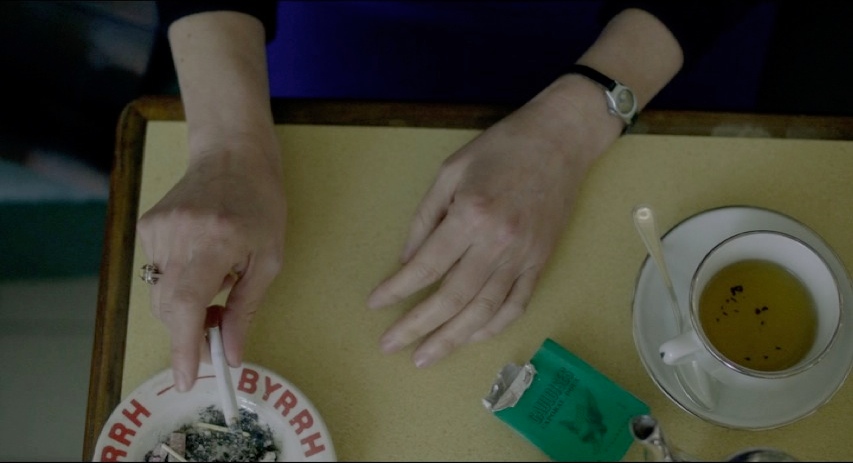
Violette (Martin Provost - 2013)
Posted by Peter Nellhaus at 09:02 AM
October 23, 2014
Crazy Dog

Canepazzo
David Petrucci - 2012
One 7 Movies Region 0 DVD
This Fall has seen a couple of the smaller DVD labels offering films that are a bit outside their usual offerings. Crazy Dog is a relatively new film, from two years ago, from a company better known for excavating some of the most obscure European movies from the Seventies and Eighties, stuff from the most forgotten corners of film history. The writeup on the DVD cover attempts to make the case for the film as something in the style of Italian cinema from the Seventies, a blend of some giallo and police thriller, but the film is, for me, nothing like that at all.
What we have is a pretty good mystery, possibly inspired by a true story, although I take such declarations with a grain of salt. Crazy Dog is the name of a serial killer who has murdered a slew of people, seemingly at random. Marco, the son of one of the victims, interviews a criminologist who seems the best informed about Crazy Dog. The criminologist recounts events from twenty years ago, when Crazy Dog struck, and then disappeared, pursued by a freelance journalist.

The serial killer signs his work, on the body of one victim, the painting of another, and in blood on the doormat of the journalist. The film ends with a flashback tying several of the victims together, but not all of them. The explanations don't entirely make sense, suggesting that when David Petrucci wrote his screenplay, he hoped that the viewer wouldn't notice plot holes the size of craters.
Petrucci tries to goose up interest with cameos by Franco Nero and Tinto Brass. Nero actually has a fair singing voice that should have been used more. Here, he's an abstract painter of sorts and philosopher, like several of Crazy Dog's victims, living in the margins. Tinto Brass, with his ubiquitous cigar, is a mobster who makes a point of getting the respect he thinks he deserves. The inclusion of Nero and Brass is an attempt to provide some tenuous link to the glory days of Italian cinema as a provider of commercially popular, if often critically maligned, films in the Seventies.
Petrucci plays with color, tinting the scenes with the murders, but otherwise, any resemblance to earlier genre films is tangential. There are no extended point of view shots, and the scenes of violence are restrained, so much so that I almost wished that Ruggero Deodato, of Cannibal Holocaust infamy, would have stepped in to show Petrucci how to make the audience pay attention to what's on the screen.

Posted by Peter Nellhaus at 06:54 AM
October 21, 2014
Kundo: Age of the Rampant
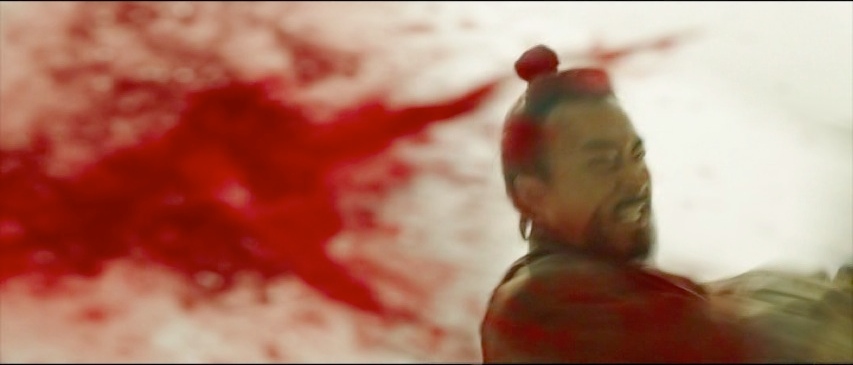
Kundo: Min-ran-eui Si-dae
Yoon Jung-bin - 2014
WellGo USA Entertainment Region 1 DVD
I would think that if anyone were to listen to the soundtrack to Kundo without knowledge of the film, hearing it cold for the first time, they would assume that the music was from an unfamiliar Italian western, and the score, if not be Ennio Morricone, than someone under the influence of the maestro. The ghost of Sergio Leone is in the film as well, with the close-ups of eyes of men challenging each other, the shots of horsemen riding the barren plain, and the lone warrior who comes alone, with a huge, where the hell did that come from?, machine gun. While this South Korean film is not as overtly indebted to Leone as The Good, the Bad, the Weird, the influence of the Dollars trilogy is impossible to miss.
Taking place in 19th Century Korea, the fate of a region is primarily played out by two outsiders, a butcher (considered the lowest in the caste system of the time) against the illegitimate son of a former governor, who acts on behalf of his father in hopes of gaining official position and acknowledgment of his paternity. The son schemes to eliminate any future heirs, and finds ways to force the peasants to give up their land, becoming slaves for a chosen elite. The butcher is compelled by circumstances to take up with an army of thieves who live in a hidden, mountain community, planning to take revenge on the injustice of the local government.
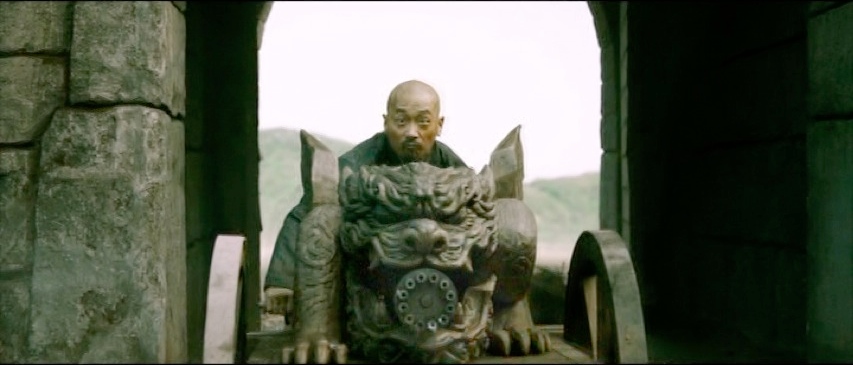
There are a couple of nice set pieces. In one, their is a fight between the government soldiers and the thieves at night. The illumination from a nearby fire and lighting provide a stroboscopic effect. The second is the final duel between the butcher and the former governor's son, done in a bamboo forest, with the trees cut down in the course of the fighting, providing both barriers and temporary platforms for each man. A chase through the bamboo forest unsurprisingly evokes memories of similar lateral tracking shots from Akira Kurosawa. Humor is provided by some very earthy dialogue, mostly provided by the band of thieves.
I think it worth pointing out that WellGo USA has significantly shortened the gap with the initial theatrical run of Kundo, last July, to its new US home video release. That short wait time for US viewers would be meaningless if Kundo wasn't worth watching, and not just a record setting box office hit in South Korea. Yoon tries to help the viewer with little freeze frame introductions to several of the characters, and there is some supplementary narration that provides historical context. Mostly, though, I would give credit to composer Jo Yeong-wook for providing the audio cues for the viewer, providing a musical shortcut to introduce the kick ass action, which needs to translation.
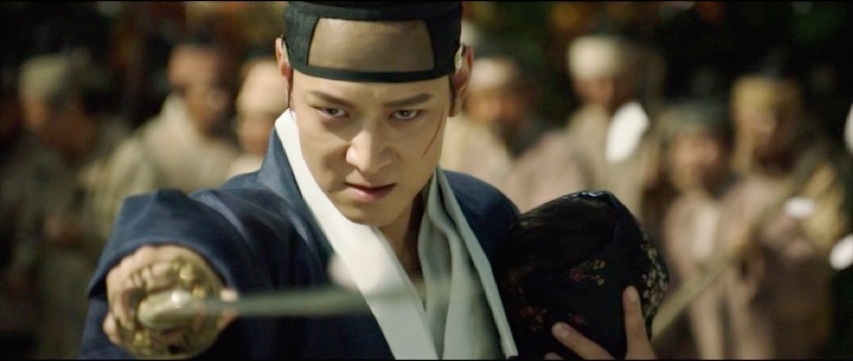
Posted by Peter Nellhaus at 05:37 AM
October 19, 2014
Coffee Break

Anna Hopkins and Paul Giamatti in Barney's Version (Richard J. Lewis - 2010)
Posted by Peter Nellhaus at 07:54 AM
October 17, 2014
Violette

Martin Provost - 2013
Adopt Films Region 1 DVD
So much of Violette seems to occur in shadows or in darkness. And some of this might be a visual signifier, with Violette LeDuc emerging from relative obscurity to late fame and fortune at about the same time that she ditches overcast Paris for sunny Provence.
As to how much of LeDuc's life was accurately portrayed in the film, I don't know. I only knew of LeDuc's literary reputation, primarily after her death. The film version of LeDuc is more complicated in terms of her sexuality, or more precisely, the disconnect between literature noted for its eroticism, and LeDuc's life mostly alone. There is the passion for Simone deBeauvoir, who refused LeDuc sexually, but in other ways proved to be of constant support, spiritually and financially. There is the constant neediness that puts off some that rightly or not, can not provide the kind of affection she seeks.
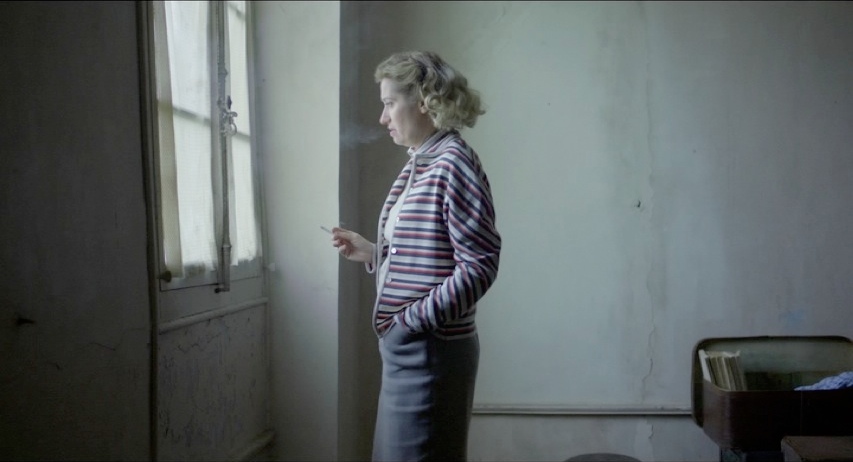
Provost's film provides a glimpse also of the politics and celebrity of the French writers who emerged after World War II, sometimes erroneously lumped together as "existentialists". LeDuc is initially helped by Albert Camus, who sponsored a series of novels by promising writers. Jean Genet thinks of LeDuc as his sister prior to their falling out. LeDuc is frustrated that her novels do not sell. The film chronicles LeDuc's fighting her own self doubts at being a writer, first encouraged by Maurice Sachs, and later by deBeauvoir, first tentatively taking pen in hand, and later pouring out her thousand paged memoirs which she assures deBeauvoir was pared to the essentials.
The film is organized by chapters, named after key people in LeDuc's development, by their first name. The first chapter is the most problematic in that if one does not know that Maurice is Maurice Sachs, the viewer might think that this is no more than a gay man, some kind of writer, who is married to LeDuc, has gotten her pregnant, and ditches her at an inconvenient time.
Arguably, it is also easier to make a film about a painter than a writer as the viewer can see examples of the art work, whereas for the writer, the hope is to convey the value with a few choice quotes and the endorsement of a few famous people. Provost's Seraphine was a more successful film because it was about a visual artist, and perhaps also because the historical setting was more remote, and the scope of the film smaller. Much of that film was from the point of view of the title character. In Violette, there is the feeling of observing a conversation where it is assumed you know what every one is discussing, that the names of writers and publishers have an understood significance.
Provost does attempt to create a visual corollary in frequently filming Emmanuelle Devos from a distance to indicate the aloneness of LeDuc. Devos, unconventionally attractive, but attractive nonetheless, is not convincing when LeDuc makes claims regarding her lack of beauty. It could well be that making a biographical film about a writer is a questionable endeavor. The films that seem to best convey what it means to be a writer are fictional, like Alain Resnais' Providence, or fanciful as in Spike Jonze's Adaptation. Ultimately, Violette is closer to a textbook, technically perfect but emotionally uninvolving, when it should have attempted to be messier and more transgressive, closer to LeDuc's life and literature.

Posted by Peter Nellhaus at 06:05 AM
October 15, 2014
Nekromantik

Jörg Buttgereit - 1987
Cult Epics BD Region A
Just in time for the holiday season, that is, if Halloween is your holiday, comes this infamous film released as a Blu-ray disc. I don't recall when I first was made aware of Nekromantik, but I was disappointed when, right after I joined Netflix in 2001, Jorg Buttgereit's film was no longer available. I guess this is an example of how good things come to those who wait, as the Cult Epics disc is loaded with both the director's version, the "grind house" version (complete with scratchy images), an earlier short film by Buttgereit, Hot Love, filmmaker's commentary tracks, and more.
Admittedly, a love story about a man, a woman, and a corpse, isn't going to appeal to everyone. On the other hand, the one left on the side of the road, I was not prepared for a film this funny. Sure, some of the over the top gore makes Herschell Gordon Lewis look like a master at discretion. Shooting Super 8, with friends over the course of many weekends, Buttgereit is closer to the Hollywood in the Bronx aesthetics of the Kuchar Brothers, if more transgressive than dared by the twins.

The tone of the film is set when a young couple, driving in the dark, try to look at a map instead of the road. Of course this leads to an accident, and what an accident. Buttgereit probably never heard of the Kuchars, and probably never heard the Jimmy Cross novelty song from 1965, "I Want My Baby Back", a parody of songs like "Leader of the Pack" and "Last Kiss". After waking up from a car crash, Cross looks for his sweetheart - "Over there was my baby. . . and over there was my baby . . . and way over there was my baby!". Hey, for some of teenagers at that time, this was pretty funny stuff the first fifty or so times we heard this song. "I Want My Baby Back" ends with Cross climbing into the coffin of his sweetheart. In short, young people, black humor, necrophilia - nothing new. Buttgereit has put on film the kind of stuff that was considered somewhat acceptable if kept in the imagination.
There has been serious analysis of Nekromantic by others. Suffice to say that this is the kind of film that will evoke different responses from different viewers, some plainly more interested in the visceral impact of the transgressive imagery than any meaning that might be derived from the strange love of Rob and Betty. For fans of Nekromantik, this new Blu-ray might constitute an embarrassment of riches. For those insisting on more tasteful artistic expressions, Nekromantic will be dismissed as an embarrassment.
Posted by Peter Nellhaus at 07:06 AM
October 13, 2014
The Devil's Business

Sean Hogan - 2012
Mondo Macabro All Region DVD / BD Region ABC two-disc set
What, ahem, possessed Mondo Macabro to take on The Devil's Business? The inclusion in their catalogue is unexpected as it is a relatively new film, made by people for whom English is their native language, and hardly what one might expect for a genre mashup that starts off as a gangster film that turns into a horror movie of sorts, where even the blood and gore might be considered done in good taste. Writer-director Sean Hogan is frank in the commentary track about the debt owed to Harold Pinter in this dialogue heavy film. I can imagine that someone picking up this film for the title might be infuriated that there is more time spent on atmosphere, with extended scenes of a couple of white guys sitting around talking, while the kind of person who's familiar with Hogan's reference to The Dumb Waiter, possibly might be dismissive of a film featuring a vampiric homunculus.

In print, it might not sound like much, but there is something intriguing about Irish actor Billy Clarke, with only the left side of his face illuminated like a sliver of the moon, talking about the ghostly apparition of a woman who appears at night. The older Pinner, and the young Cully, two hit men, sit and wait in home of their victim, out for a night at the opera. For Pinner, "A job is a job", and waiting is part of what is required. Cully is impatient for something to happen. What begins as the story of two hit men waiting in the dark, turns into something else when the pair finds a room with a giant pentagram, a goat's head, and dead body.
This is also the kind of film I like to recommend to other filmmakers, to see what can be done with just a handful of actors, and a small digital camera. The commentary track is worth listening to, as producer Jennifer Handorf discusses some of the last minute changes done when the original location was lost, and production moved to the family home of her in-laws. Sean Hogan doesn't shy away from mentioning some of his sources for inspiration. Hogan doesn't attempt to pad things out, so that the film clocks in at about seventy minutes, taking in the lesson from Val Lewton that it is better to suggest horror with what you don't see, and let light and shadows do most of the work.
The DVD/Blu-ray set discs include interviews with Hogan, Handorf, Clarke and composer Justin Greaves, as well as a couple of music videos by Hogan.

Posted by Peter Nellhaus at 06:16 AM
October 12, 2014
Coffee Break
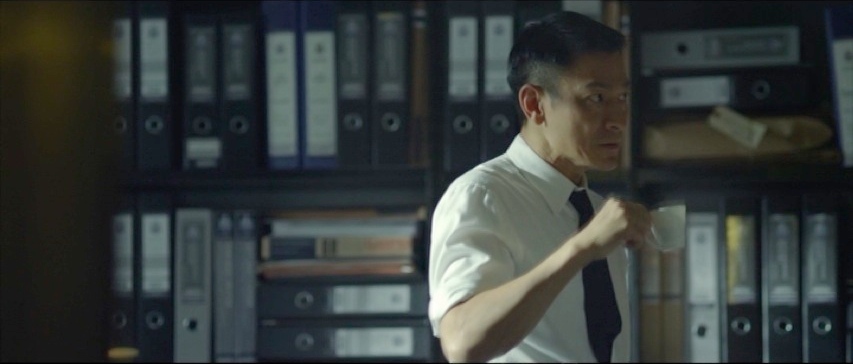
Andy Lau in Firestorm (Alan Yuen - 2013)
Posted by Peter Nellhaus at 06:03 AM
October 09, 2014
Chanthaly

Mattie Do - 2013
Lao Arts Media DVD
An admission here, that I have exchanged emails with the director and am a Facebook friend. If that doesn't bother you, read on . . .
Living even a few months in Thailand provided enough of an impression on me. Between the movies, with what seemed to be a new ghost story every other week, and just walking by the little ghost houses scattered throughout Chiang Mai, I started adapting the attitude that, yes, ghosts were among us, and as long as you don't bother them, they won't bother you.
Even though the basic premise of the Lao Chanthaly is similar to that of Thai films, that ghosts live among us, that is the extent of the similarity. No one runs around screaming hysterically. Nothing here to make the audience scream or laugh, or scream followed by laughter (and nothing compares to watching a Thai horror movie with a Thai audience). If anything, Chanthaly is more similar to Alejandro Amenabar's The Others, with the idea that ghosts live among us, but in a parallel environment within the same space.

The title character, a young woman, has a combination ghost house and altar dedicated to her deceased mother. Has she actually seen her mother's dead body, fifteen years earlier, the result of suicide by hanging, or is the a false memory? Her father insists that Chanthaly's mother died shortly after giving birth to Chanthaly. At various points, the viewer is teased into not being entirely sure about who is telling the truth. Chanthaly lives in virtual seclusion with her father in a firmly middle class house, providing a small laundry service from home, but otherwise never leaving the premises. Diagnosed with a weak heart, she is locked in, as she is told, for her protection.
While Chanthaly has been noted as the first horror film in the Lao language, the horror elements are minimal. What caught me off guard was that Mattie Do, and screenwriter Christopher Larsen eschewed many of the conventions one comes to expect from seeing a ghost story from Southeast Asian filmmakers. The first hour, especially, is closer to the more highbrow psychological horror films that more frequently garner critical attention.
The argument presented by Chanthaly's father and a doctor who treats her, is that a belief in ghosts is superstitious. For myself, as a Buddhist, I had to wonder what kind of karma would visit the father after he knock's down Chanthaly's altar. Some of the choices in the narrative were probably determined by the extremely limited budget, shooting in one location, with five actors and a dog. For those who have some kind of belief in the afterlife, Chanthaly suggests some reassurances. For others, this can be appreciated as a solid first film.
Posted by Peter Nellhaus at 06:32 AM
October 07, 2014
The Slave

Scacco alla regina / Check to the Queen
Pasquale Festa Campanile - 1969
Mondo Macabro DVD Region 1 / BD Region A two disc set
Because she never appeared in any films that either got stateside theatrical release or any serious critical attention, I had made the assumption that Eric Rohmer's La Collectionneuse was the beginning, and end, of Haydee Politoff's acting career. I had forgotten that she also appeared in Rohmer's Love in the Afternoon. Seeing here name prominently listed for this film sparked my curiosity. Even though she is second billed here, Politoff has the title role. One can possibly interpret The Slave as being somewhat allegorical regarding Politoff's career as an actress, being passive about her choice of roles, going where the offer was most financially rewarding, and drifting away from acting when the producers stopped calling for her.
The opening titles of The Slave are printed over colored versions of Rorschach ink blots. Festa Campanile emphasizes the psychological aspects of the story over the erotic, which may well explain why the film failed at the box office. The film was one of a handful of films Festa Campanile made, hoping to repeat the international success of The Libertine. Most of eroticism here involves the masochistic fantasies of Sylvia, the character played by Politoff, on the receiving end of a woman's whip, the action obscured by heavily tinted lenses. The original title refers to a movement in a chess game, something apparently explained better in the source novel than in the film.

Sylvia takes on the job of being a non-sexual companion to the actress, Margaret, to keep from being bored with her upper class existence, giving her the illusion that she is doing something with her life. There is something self-contradictory as Sylvia also chooses to live in the most isolated way possible, away from as much outside stimulus as possible. Sylvia surrenders herself to Margaret, picking up after her, dressing as ordered, allowing herself to be transformed into a living statue, or become her footrest. Sylvia also deliberately gets caught with Margaret's lovers in order to be punished by Margaret. Yet in spite of living in an all female household, save for the chauffeur, Margaret has no sexual interest in other women, and toys with Sylvia's sapphic desires before ultimately rejecting her.
The Slave may be of greatest interest to those who love the films primarily from Italy and France that appeared in the late Sixties and early Seventies. The sexual subject matter was in part a reaction to the newly-enacted ratings code in the U.S., itself a reaction acknowledging that audiences were flocking to European films with their brief glimpses of nudity and more adult themes. One of supplements is a discussion of the films by Festa Campanile by critic Roberto Curti. There are also some trailers to other films by Festa Camanile. The brief look as Con quale amore, con quanto amore, with one woman slowly removing the stocking from another woman as a prelude to lovemaking, is quite sexually charged.
I suspect that Pasquale Festa Campanile's film will be remembered better for the sets and costumes, and serve as a snapshot of a certain era. A couple of the more memorable images are of star Rosanna Schiaaffino, seen on a floor surrounded by paper lira, and as a visual reference to the film's thematic concerns, as a Venus in fur.

Posted by Peter Nellhaus at 07:16 AM
October 05, 2014
Coffee Break

Florence Guerin and Marino Mase in L'attrazione (Mario Gariazzo - 1987)
Posted by Peter Nellhaus at 07:17 AM
October 02, 2014
Iguana

Monte Hellman - 1988
Raro Video BD Region A
Even though I think it's good that Monte Hellman's cut of Iguana is available, I still feel ambivalent about the film. I don't have any explanation other than that I don't connect with this film as I have with the others, and I have seen most of Hellman's films, the exceptions being Flight to Fury and China 9, Liberty 37. Still, there are things that I missed in a previous viewing on the original DVD release.
What did work for me was when Hellman cut between the character of Oberlus, the sailor with the scaly half face, and Carmen, the woman Oberlus would eventually kidnap to make as his unwilling wife. Oberlus rebels against both the mistreatment received by his fellow sailors, as well as maritime law. Carmen enjoys sexual freedom and rebels against the laws of the Catholic Church. Oberlus escapes from the ship he is on, finding himself on a small island where he proclaims himself king. He discovers a castaway, Sebastian, whom he makes his slave. At one point, Sebastian calls Oberlus a monster. Hellman cuts to Carmen telling a lover that she is not a monster. The characters are ultimately bound by institutionally established rules. Self-created senses of freedom are either short-lived or illusory.
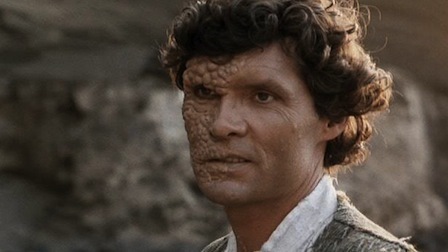
I do have the nagging feeling that I should be seeing one of Hellman's favorite films, Outcast of the Islands, to have a better sense of what Hellman was aiming for. The Carol Reed film and Joseph Conrad story have some similarities, with a sailor protagonist destroyed by his own arrogance. I am simplifying things here, and Hellman never mentions Reed's film in any interviews about Iguana, but even the couple of video clips I saw of Outcast of the Islands right after seeing Iguana made me think there is some connection.
What did catch me off-guard was the introduction of the Iguana himself, Oberlus. He's first seen in profile, tossing his harpoon at another sailor who has insulted him. When Oberlus is first seen full face, I had to remember that I only imagined what he looks like based on the profile. There is never an explanation for why Oberlus has a disfigured half-face. It doesn't take too much psychological acumen to see Oberlus as a study in a man's dual nature, with the side considered monstrous overwhelming the less frequently seen human side. Without revealing too much, the film ends in a way that can be considered ambiguous, where the final act of Oberlus might be seen as both monstrous and humane.
The Blu-ray comes with a short interview with Monte Hellman, explaining how he got involved in making Iguana, as well as some stories about the production, and the fate of the film upon completion. There is also additional information in the booklet with an interview by Fangoria's Chris Alexander. I'm not sure why it wasn't mentioned, but while the filmography and interview include Avalanche Express, with Hellman completing the work of Mark Robson, who died prior to post-production, there is no mention of The Greatest, with Hellman finishing up for the late Tom Gries.
Posted by Peter Nellhaus at 06:50 AM
